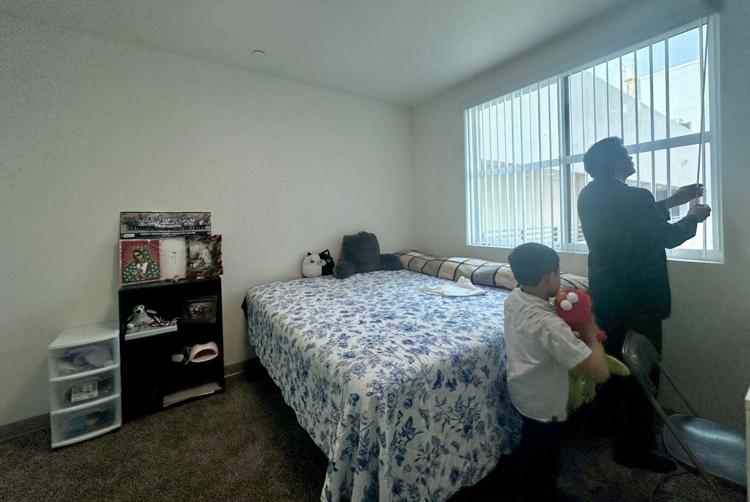After ten years, Los Lirios now houses more than 160 low-income or previously housing-insecure people
- By Brenda Fernanda Verano CALÓ News
- Nov 15, 2024 Updated Nov 18, 2024
Robert Silva, 41, is a single dad of five children, working as a manager in a storage facility.
“I get to have a Thanksgiving, Christmas and New Year’s after five years of being homeless,” Silva said on Friday morning.
Silva’s family now has a home at the Los Lirios housing development.
Silva talked about the adversities of being homeless and how he “hit rock bottom,” unable to find any resources for fathers like him.
“The kids are the future. We don’t want them out there in the streets. We don’t want them to grow up thinking that the streets are somewhere safe because they’re not; home is safe and without these apartments, [my son] wouldn’t have a safe place,” he said on Friday morning while he held his youngest son.
“An outstanding project” is what Los Angeles County Supervisor Hila Solis called Los Lirios, a mixed-use housing development for low- and moderate-income households that was inaugurated and presented to the community on Friday morning.
The five-story, 64-unit affordable housing complex, located right outside of the Metro E Line Soto station, is the latest effort to increase the supply of affordable housing and tackle the housing crisis in the city and county.
The new development, which has a cost of 52 million, is a mixed-use housing development set aside for formerly homeless households or low- and moderate-income families like that of Silvia Aguirre.
Aguirre and her husband, Erazmo, along with her two kids, inhabit a three-bedroom unit and are now one of the 160 low-income individuals housed in Los Lirios. Aguirre said the best thing about receiving housing within the facility is seeing her kids have their own space and bedrooms to play, walk around and grow up. But things were not always like this for the family.
Before Los Lirios, the Aguirres lived in South Central, L.A., in a one-bedroom rear unit infected with mold and with no natural sunlight, air conditioning, or heater. They lived in this rear unit for 15 years.

“This was our reality for a long time, and it continues to be the reality of many low-come people in our city today,” Aguirre told CALÒ News.
Today Aguirre’s two kids have developed asthma.
“In our old place, it was during the winter time when the kid’s asthma used to get worse because the [air quality] would worsen,” she said. “This will be the first year where they will live somewhere better since they were born.”
The residential facility was developed in partnership between the Los Angeles County Metropolitan Transportation Authority (Metro), the East Los Angeles Community Corporation (ELACC) and BRIDGE Housing Corporation (BRIDGE). Los Lirios resides on Metro-owned land—land that is then leased by Metro for better use, like that of building affordable housing.
“These projects have proven to lower the cost per living of our residents by addressing what is most important: making sure that we bring down those high expenses for housing and include affordable transportation,” Solis said. “This is just one of the many [housing projects] that are coming and that are in the queue.”
Using Metro-owned land for housing is not new and is part of the Metro’s Joint Development program, where the multibillion-dollar transit institutions pledged to build 10,000 homes by 2031, 5,000 of which were promised to be income-restricted.
“To meet our goals, Metro has partnered with developers such as ELACC and BRIDGE to increase the supply of high-quality housing on Metro properties, especially income-restricted properties and apartments.” Ray Sosa, Metro chief planning officer, said on Friday.
In the last few years, Metro has identified 20 new development opportunities that will be made available for competitive developer proposals in the coming years.
More than tackling the housing crisis, Sosa also said housing projects like Los Lirios reduce auto use by directly linking Metro’s transportation network to commercial and housing opportunities, which helps to increase transit ridership.
“We serve as a gateway to the metro transit system… To be able to take this train now, not only into Downtown Los Angeles, to Union Station, but with the regional connector, go to USC, the west side, Culver City, and all the way down to Santa Monica,” he said.
Aguirre said having her home just outside of the Metro E Line to Soto Station has also helped her preserve her community and friendship in South Central, which she can get to in approximately 20 minutes when taking the train.
“We still go [to South L.A.] various times a week. That was our community for a long time,” Aguirre said. “My daughter still goes to school there, as she has asked me not to change her schools, so I take her every day on the train.”
However, the compilation and construction of Los Lirios were not easy and even less rapid. The project began in 2014.
With a red ribbon in hand, signifying “the red tape,” that “makes it unable to build affordable housing,” Monica Mejia, president and CEO of ELACC, walked on stage and talked about the obstructions and major delays that make building affordable housing units a hard and complex process.
ELACC, along with Bridge, both served as the developers of Los Lirios.
“It took 10 years to get 64 apartments ready for occupancy. That is too long,” Mejia told attendees of the ribbon cutting and inauguration on Friday. “There are developers who are no longer doing affordable housing. They’ve stopped because it’s just too impossible and irrational to be in this system.”

Mejia mentioned some of the city and county-wide roadblocks that the developers encountered throughout the 10 years. It took three years to assemble the financing, including a couple of times developers had to reapply for funding for the project, according to Mejia.
She also mentioned a setback during the construction phase. “We were unable to bring electricity to the property from the street,” she said, something that, according to her, caused an 11-month setback.
“Affordable housing needs a straight path, a clean, straight, forward path. So we can really serve the people of L.A.” she said. “Despite all the red tape, we did have something very special to help build Los Lirios; we had teamwork.”
She later told CALÒ News that to combat some of the red tape that impedes building affordable housing in urban cities like L.A., every public space in the city should already be entitled to affordable housing right now, especially as the need for housing increases. “There should be no question that a particular site is entitled for affordable housing. The only places [that would be off limit] are unsafe, polluted areas, but everything else should be ready to go for affordable housing.”
The need for affordable housing has never been greater, according to housing advocates and experts. As stated by the 2024 Greater Los Angeles Homeless Count, there were 75,312 unhoused people in the county and 45,252 unhoused in the city of L.A. in 2024.

The report also concluded that family homelessness increased by 2.2%, although many families are in temporary housing.
The need for affordable housing was highly noticeable just in the amount of applications that were submitted for Los Lirios. There were a total of 9, 500 affordable housing applications submitted on Los Lirios alone, the majority of which are on the waitlist, a list that, according to project leaders, is very unlikely to open soon.
“At BRIDGE, we recognize that a home is much more than shelter; it’s a source of dignity and a stepping stone to a better life,” Ken Lombard, president of BRIDGE Housing, said. “The scale of the housing crisis is demanding more homes. We are eager to stand shoulder to shoulder with each of you to continue to be part of the solution and allow every resident and family to access the affordable home they deserve.”
Apart from housing, families and the 230 people who will live in Los Lirios will benefit from onsite resident services and supportive services offered by ELACC. Some of these services include helping residents build on their self-sufficiency, fostering community connections, supporting whole-household success, promoting healing and recovery and most importantly, maintaining housing stability.

“In Boyle Heights, as well as many neighborhoods in the First District, the need for affordable housing for low- and middle-income families has never been more urgent. Many of our residents also rely on public transportation or alternative means of travel in order to get to school and work,” Solis said.
The new building also includes residential amenities such as onsite offices for management and service providers, a workout room, on-site laundry, a community room, a children’s play area, and an outdoor courtyard.
Resident services are provided by ELACC, and PATH Ventures provides case management and supportive services for formerly homeless households.
Aguire told CALÒ News she had been applying for affordable housing for years. “I don’t even recall how many applications our social worker helped us submit, but they were a lot,” she said. She encourages low-income people to not give up and continue applying for county and city-wide affordable housing.
“This is a dream I thought was unattainable, but today it is a dream come true for my family and many others living in Los Lirios,” Aguirre said.

